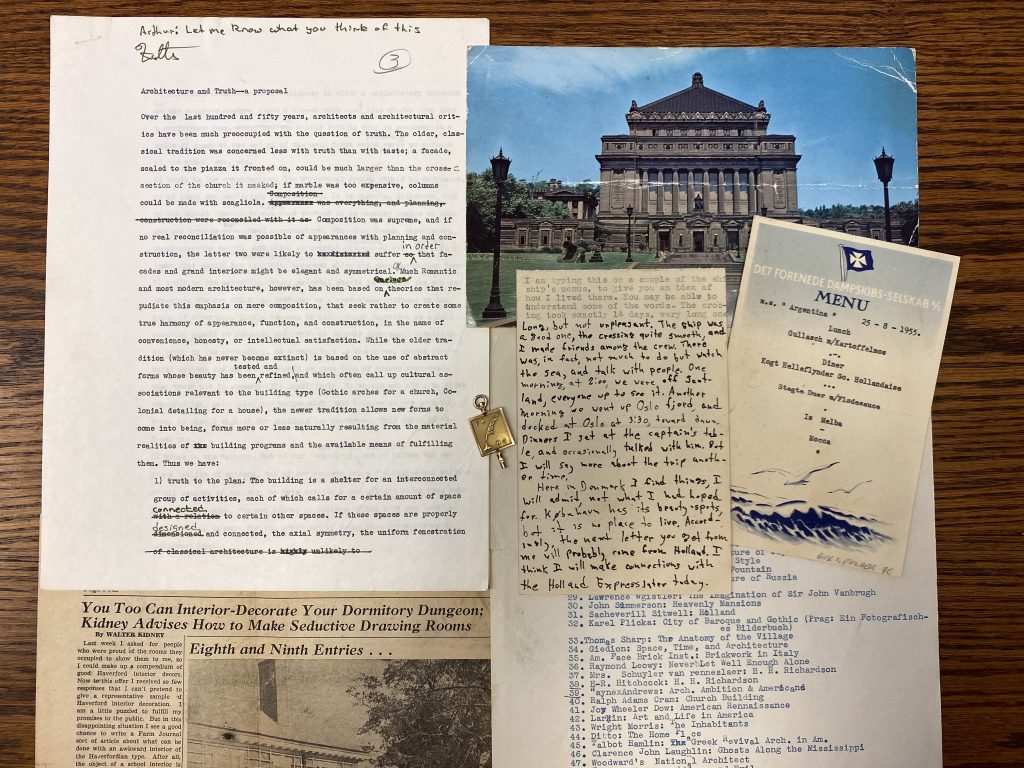
Author Archives: karamagi
-
An Update From Our Archives: Rehousing Project Completed
Our organization has completed a grant-funded records rehousing project that allowed us to review, reprocess, and rehouse the papers of three former PHLF staff members: founding Chairman Charles C. Arensberg and architectural historians James D. Van Trump and Walter C. Kidney.
Over the past year and a half, Archivist Anna Samuels and two interns from Duquesne University’s Public History graduate program reviewed materials and transferred all documents to acid-free folders and boxes, reorganized materials as necessary, and digitized fragile manuscripts. By rehousing the collections, we’ve ensured that these materials will be preserved for years to come.
Charles C. Arensberg was PHLF’s founding chairman and served on the board for 30 years. His collection offers a fascinating behind-the-scenes glimpse into the founding and early operations of the foundation. Highlights include Arensberg’s “Chairman’s Ramble” column that ran in our PHLF newsletter, assorted letters to the editor he authored, and materials related to his tenure on the National Trust of Historic Preservation’s Board of Advisors.
Walter C. Kidney served as PHLF’s architectural historian for nearly 20 years and his collection contains correspondence, research and manuscripts. During her internship, Katie Ploger discovered some hidden gems within the collection: “Shuffled in the correspondence and in later boxes of the collection were more personal things that belonged to [Kidney]. Letters to friends and family, mementos of childhood and travel, and other personal belongings could be found within the collection. One of the most eye catching and interesting of these documents is a letter from Walter to his parents in the 1950s on the ship “Argentina” on a voyage to Denmark. The letter is written on the backs of two ships menus featuring broiled halibut, fried pigeon in a cream sauce, and roast pork with red cabbage.”
James D. Van Trump was co-founder and PHLF’s first architectural historian. Intern Hannah LeComte reviewed correspondence, research materials, photographs, and handwritten manuscripts, noting themes of “urban development and ‘renewal’ in industrial and deindustrializing cities, historic preservation and the field’s connection to the environmental movement, and documentation of grassroots efforts to determine which sites deserve protection and preservation.” LeComte reflected on her work with the collection, writing, “Housing some of the foremost scholarship on the history of Pittsburgh architecture and development, the Van Trump Papers provide a unique way to study architectural history and historic preservation efforts in Pittsburgh and connect these efforts to broader trends in 20th Century United States history. The personal papers of James Van Trump integrate a human element to his extensive scholarship and provide insight into his motivations and desires as a researcher, advocate, teacher, and friend.”
The Charles C. Arensberg, Walter C. Kidney, and James D. Van Trump Collections are available for members and researchers to access in the James D. Van Trump Library in the PHLF offices. Contact archivist Anna Samuels (anna@phlf.org; 412-471-5808 ext. 542) to set up an appointment to visit the archives.
This project was supported by a grant from the Pennsylvania Historical & Museum Commission’s Historical Archives & Records Care Grant, a program funded by the Commonwealth of Pennsylvania.
-
Three Scholarships and Ten Honorable Mentions Awarded in 2024 Cycle
Our organization has awarded three scholarships and 10 Honorable Mention-awards to college-bound students in Allegheny County, who care deeply about the history and distinctive built environment of our city and region.
The scholarship award of $6,000 is payable over four years, while the Honorable Mention award is a one-time gift of $250, payable to the recipient’s college or university for tuition and book expenses.
At its meeting on May 17, the Landmarks Scholarship Committee awarded scholarships to:
- Isabel Concepcion of Woodland Hills High School, who will attend the University of Pittsburgh;
- Rena Gilligan of Quaker Valley High School, who will attend Stonehill College, and
- Daniel Kelly of Pittsburgh Carrick, who will attend York College of Pennsylvania.
Our Honorable mention recipients are:
- Elliott McInnes (Pittsburgh Obama High School/Temple University);
- Dylan Berman (Fox Chapel Area High School/Vassar College);
- Louis Mariano (Montour High School/University of Pittsburgh);
- Kendall McKelvey (Northgate High School/Oberlin College);
- Raelle Wilshire (Blackburn Study Center Homeschool/Grove City College);
- Dimajio Bailey-Locante (Keystone Oaks High School/Slippery Rock University);
- Angel Qu (North Allegheny Senior High School/Rice University);
- Luke McDonough (Upper Saint Clair High School/New York University);
- Brendan Harris (Baldwin High School/University of Notre Dame);
- Max McCarran (Shady Side Academy/Dartmouth College).
The awards will be presented during a private reception on Thursday, June 20, where we look forward to meeting our award winners together with their families.
Launched in 1999, our organization has so far awarded 91 scholarships and 69 Honorable Mentions to high school graduates from Allegheny County who care deeply about the Pittsburgh region and are pursuing an undergraduate degree at a college or university of their choice. The Scholarship Program has helped introduce young people to the work and mission of our organization and has created a network of support and sense of family among the recipients.
Applicants are asked to write about a place in Allegheny County that is meaningful to them. David Brashear, who chairs the Scholarship Committee, said this year’s essays were, as usual, “outstanding and insightful.” They featured essays on places, which included Phipps Conservatory, Monongahela Incline, St. Paul’s Evangelical Lutheran Cemetery, Riverview Park, Hartwood Acres, Mellon Park, Acrisure Stadium, Benedum Center, Muslim Community Center of Greater Pittsburgh, and Rosedale Beach Club. The essays from all the applicants are bound and archived at PHLF.
Mr. Brashear’s family initiated the Landmarks Scholarship Program in 1999 through a Donor-Advised Fund at PHLF. Foundations, businesses, and many PHLF members have generously contributed since then.
We welcome contributions in support of the Landmarks Scholarship Program. Please click here to contribute; be sure to designate your gift to “Scholarship.”
Thank you!
-
Pine-Richland Sixth-Graders Complete Architecture Apprenticeship
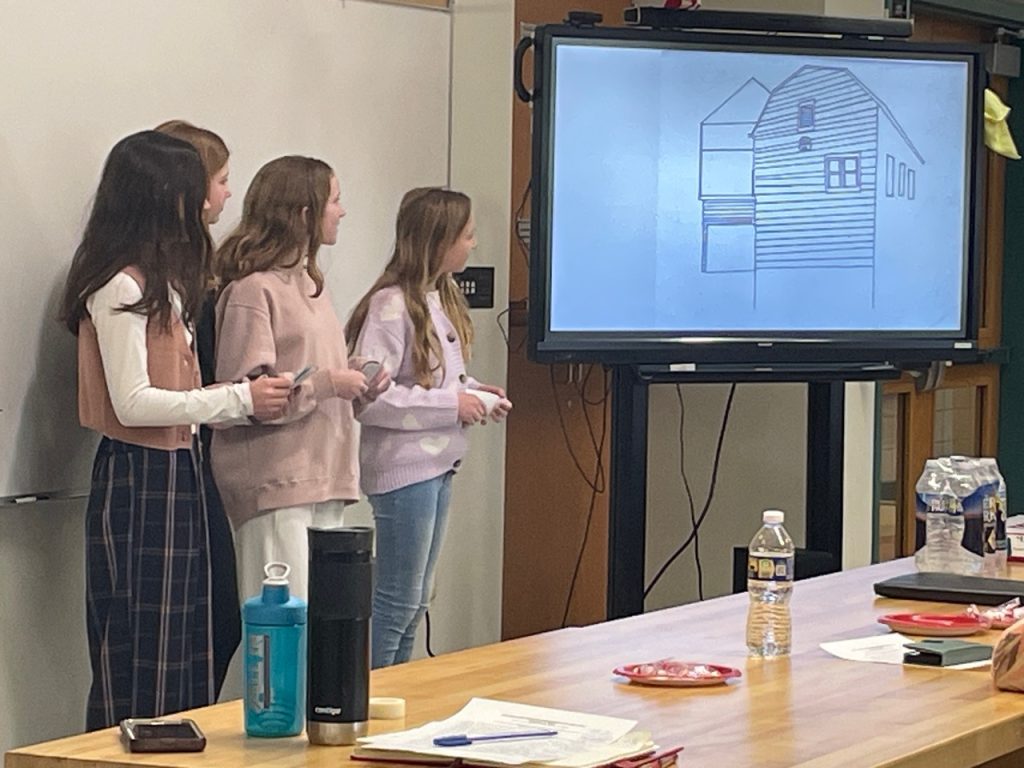
A group of sixth-graders posing as the members of an architecture firm, MCCV Architects, made a presentation showing the evolution of their project for the Pine-Richland Architecture Apprenticeship. This team and ten others designed re-uses of a small building on the Eden Hall campus of Chatham University to sustainably address needs specified by the university, which served as the students’ client. For the ninth consecutive year, gifted students at Eden Hall Upper Elementary School in the Pine-Richland School District took part in a program that brings to light the mutually reinforcing benefits of historic preservation and environmental sustainability.
Working in eleven teams, the 45 sixth-graders proposed ideas for re-use of a small 1913 Dutch-gabled house on the Eden Hall campus of Chatham University as either a recreation center, a building to support campus farm operations, or a bicycle repair and rental shop.
The three programs were specified by faculty and staff at Chatham, the “client,” which has partnered with our organization since the program’s inception. The students’ work started in the fall semester, culminating in formal presentations, in early February, to their teachers, a team of architect mentors brought together by our organization, and a large number of parents.
Awards were given to recognize not only outstanding design, but also achievement in presentation—i.e., in how well the students communicated their ideas through architectural drawings and models.
Mary Whitney, who is the sustainability director for Chatham’s campuses, said she was “blown away” by the students’ designs. “They really did their research and listened to what we [the client] told them.”
The Architecture Apprenticeship program fulfills some of Pennsylvania’s educational standards for career education by introducing students to the various professional roles involved in architecture, historic preservation, and sustainability.
Jennifer Kopach and Joanna Sovek, the teachers, also see the program’s iterative process as imparting to the students an invaluable framework for navigating life, regardless of the fields the students eventually pursue.
“The students have to respond to the client’s needs and incorporate into their designs the feedback they receive from the architect mentors in multiple reviews,” said the teachers.
Through that process, they added, “the students learn that nothing is perfect on the first try and that being able to accept and integrate constructive criticism is important, and by working in teams, they also come to understand the need for compromise.”
-
Landmarks Scholarship Program Marks 25 Years
We are pleased to announce that our Landmarks Scholarship Program, now celebrating 25 years of recognizing high-achieving, community-minded, college-bound students in Allegheny County who care deeply about the Pittsburgh region, has awarded three scholarships and eight honorable mentions to students as part of the 2023 program.
We look forward to celebrating these students’ achievements together with their families in an afternoon reception, which will be in the dining room of the Grand Concourse Restaurant in Station Square on July 12.
Our Landmarks Scholarship recipients are:
- Emily Barrie (Upper St. Clair High School/University of Virginia);
- Andrew McLaughlin (North Allegheny Senior High School/University of Pittsburgh); and
- Nelson Morris (Pittsburgh Westinghouse/Penn State University).
The scholarship award of $6,000 is payable over four years to the recipient’s college/university to help pay tuition and book expenses.
Our Honorable mention recipients are:
- Taylor Billet (Riverview Jr.-Sr. High School/Ohio University);
- Kendal Chilcoat (Pine-Richland High School/University of Pittsburgh);
- Dylan Folan (Pittsburgh CAPA/University of Pennsylvania);
- Maya Leyzarovich (Shady Side Academy/University of Pennsylvania);
- Lindsey Storey (Gateway High School/University of Pittsburgh);
- Annali Thomas (Thomas Jefferson High School/Slippery Rock University);
- Sejal Verma (South Fayette High School/Purdue University); and
- Brayden Wisniewski (Avonworth High School/Savannah College of Art & Design).
The Honorable mention award is a one-time gift of $250, payable to the student’s college/ university to help pay for tuition and book expenses.
We thank the trustees and members of our organization who have served on the Landmarks Scholarship Committee, and especially David Brashear, who as chair of the committee for 25 years, shepherded this program, which helped introduce young people to the work and mission of our organization. Two former scholarship recipients have served as trustees of PHLF––Todd Wilson and Kezia Ellison––and many others contribute their time and expertise as members.
Our organization has awarded 88 scholarships and 59 honorable mentions to high school graduates from Allegheny County since the creation of this scholarship program in 1999. Applicants are asked to write about a place in Allegheny County that is meaningful to them.
The essays this year were outstanding and insightful. Featured places included the Gilfillan Farm in Upper St. Clair, the Homewood neighborhood, Allegheny County Courthouse, Bridge of Sighs, the former Pittsburgh Athletic Association clubhouse, St. Nicholas Church in Millvale, Carnegie Science Center, Mister Rogers statue on the North Shore, Frick Park Market, and Klavon’s Ice Cream Parlor. The essays from all the applicants are bound and archived at PHLF.
PHLF welcomes contributions in support of the Landmarks Scholarship Program. Please click here to contribute; be sure to designate your gift to “Scholarship.”
Thank you!
-
Architectural Design Challenge Helps Sixth Graders Imagine Reuse of Historic House
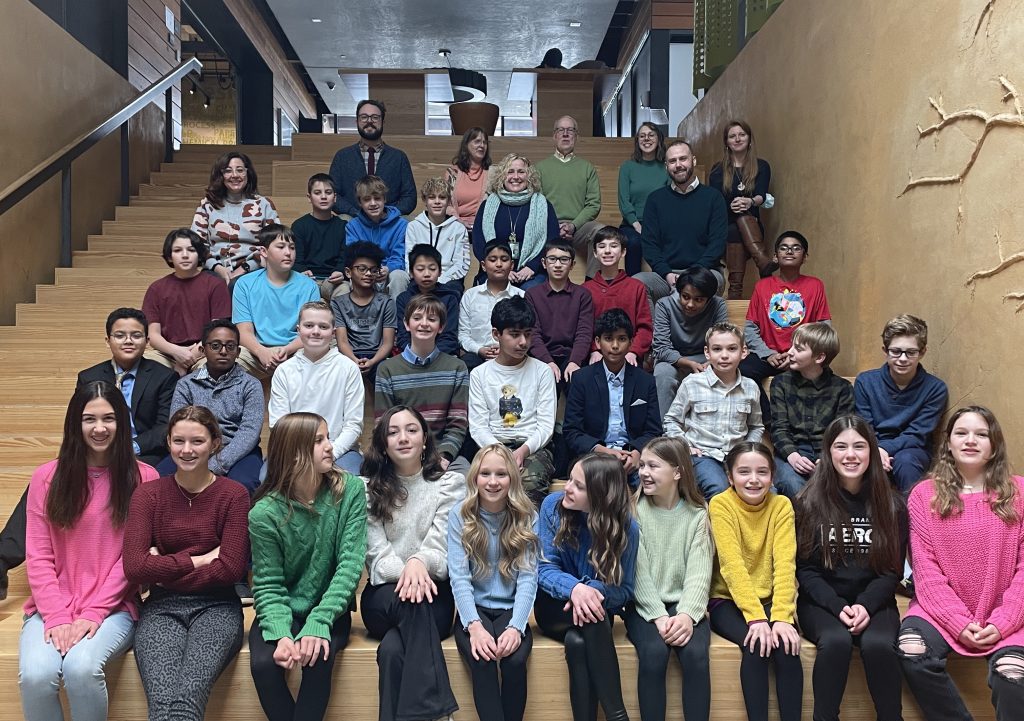
Gifted sixth-grade students from Eden Hall Upper Elementary in the Pine-Richland School District gather on the steps of the Esther Barazzone Center at Chatham University’s Eden Hall Campus after making final presentations in PHLF’s 8th Annual Architectural Challenge. Accompanying them are their teachers, the panel of architects who reviewed their work, and representatives of the Eden Hall Campus who were the students’ clients. Thirty-one gifted sixth-grade students from Pine-Richland School District’s Eden Hall Upper Elementary School presented design concepts for repurposing a 111-year-old house on the Eden Hall campus of Chatham University, on January 27.
The presentations were part of our Architectural Design Challenge, a component of our educational program to help young people imagine how to relate to our city and region’s architecture, and historic preservation of the built environment. As it has been in previous years, the Challenge site was the Morledge House—a roughly 1800-square-foot house and garage with a Dutch gambrel roof, located on the Eden Hall Campus.
This year, Pine-Richland teachers Joanna Sovek and Jennifer Kopach proposed a substantial change in the program. Instead of designing for whatever use suited their fancy, student teams would now work for a client that had specific programmatic requirements.
“The State of Pennsylvania’s academic standards include a career awareness component for our kids. We thought this program could provide a great opportunity to give students direct experience working in a creative, collaborative way that requires them to solve particular architectural problems,” said Ms. Sovek and Ms. Kopach.
The teachers’ idea meshed perfectly with the conditions on the Eden Hall Campus, which has been a valued partner since we created the program in 2015.
Kelly Henderson, K-12 education coordinator at Eden Hall, canvased colleagues there about the unfilled facilities needs in their departments. Together, they came up with three possible architectural programs for the eight student teams to wrangle out of the Morledge House:
- A recreational center where students could relax—whether passively, by simply “chilling,” or actively, through outdoor or indoor diversions.
- A bike shop, at which the campus’s bikes would be stored, rented, and repaired and where students could learn to fix bicycles.
- A space to support the farm team, which grows food that is used on campus and conducts research on agricultural sustainability.
Student teams met with the clients during the program to learn about what they needed or wanted, and to ensure that they were being responsive to the clients.
To make the Challenge even more realistic, students assumed specific roles that would be found on an architectural project with this scope and goals: LEED-certified architect, preservationist, landscape designer, interior designer, drafter/digital modeler, and project manager.
Students presented their projects to a panel of four architects (Ray Bowman, Nicole Cicconi, Paul Tellers, and Rob Zoelle) and two of the clients. Awards were presented in several categories that recognized the varied skills needed for complex architectural projects. The panel gave the award for Best Project Overall to the team calling itself Apex Architecture Firm, for “The Bike Barn.”
Inspired by the “casual-meets-elegant” aesthetic of so-called Wedding Barns, it maintained the building form and reinforced the structure to accommodate heavier loads; used reclaimed wood for storage furniture and other furnishings; and proposed use of a pulley system to move heavy boxes to the attic-level storage. Dr. Mary Whitney, Sustainability Director for Chatham University and the client for the bike shop program, was impressed by the team’s responsiveness to her feedback on its initial design. “I felt very heard: they really listened to what I told them!”
Ms. Kopach and Ms. Sovek were “beyond proud” of their students for the sophistication of their design solutions and the maturity with which the teams made their well-practiced presentations. By way of closing remarks, juror Paul Tellers, a PHLF docent and practicing architect, told the students that the problem-solving process they experienced through this program would serve them well in the future.
“Working together, learning to compromise, responding to specific needs, communicating your ideas—you need to be good at all these things, regardless of what you do later in life,” he said.
In addition, learning about historic preservation and sustainability are the big lessons to be gleaned from this Architectural Design Challenge.
-
Landmarks Community Capital Seeks Your Input in Application for Funds to Mitigate Impact of Covid-19
Landmarks Community Capital Corporation (LCC) — a non-profit lending subsidiary of our organization — advances historic preservation by helping to finance real estate development projects that facilitate the renovation of buildings in low-to-moderate-income and historic neighborhoods and communities in the Pittsburgh region.
Certified by the United States Department of the Treasury as a Community Development Financial Institution (CDFI), LCC utilizes its preservation lending to help improve different communities in Western Pennsylvania.
During the two-year period of extreme social distancing related to the ongoing Covid-19 pandemic, analytical data indicates that many of the communities we serve have been disproportionately impacted in areas concerning housing, access to healthcare, jobs, mental health providers, and the ability of a small business to operate.
In 2021, Congress authorized approximately $1.73 billion for the 2022 Treasury’s Community Development Financial Institutions Fund (CDFI Fund) to help communities all across the country respond to the economic impact of the Covid-19 pandemic.
Our organization is applying for funds from the CDFI Equitable Recovery Program (CDFI ERP) to help increase the capital available and our capacity to serve the communities where our loans are much-needed by a diverse range of business owners and developers.
As part of this process, we are seeking input on how these funds can be best utilized in our community service area. Please contact our Senior Loan Officer Rob Wagner: rob@phlf.org or 412-471-5808, ext, 538 to give us your thoughts as part of the open comment period of our application.
-
Landmarks Scholarship Reception Celebrates Community-Minded Young People
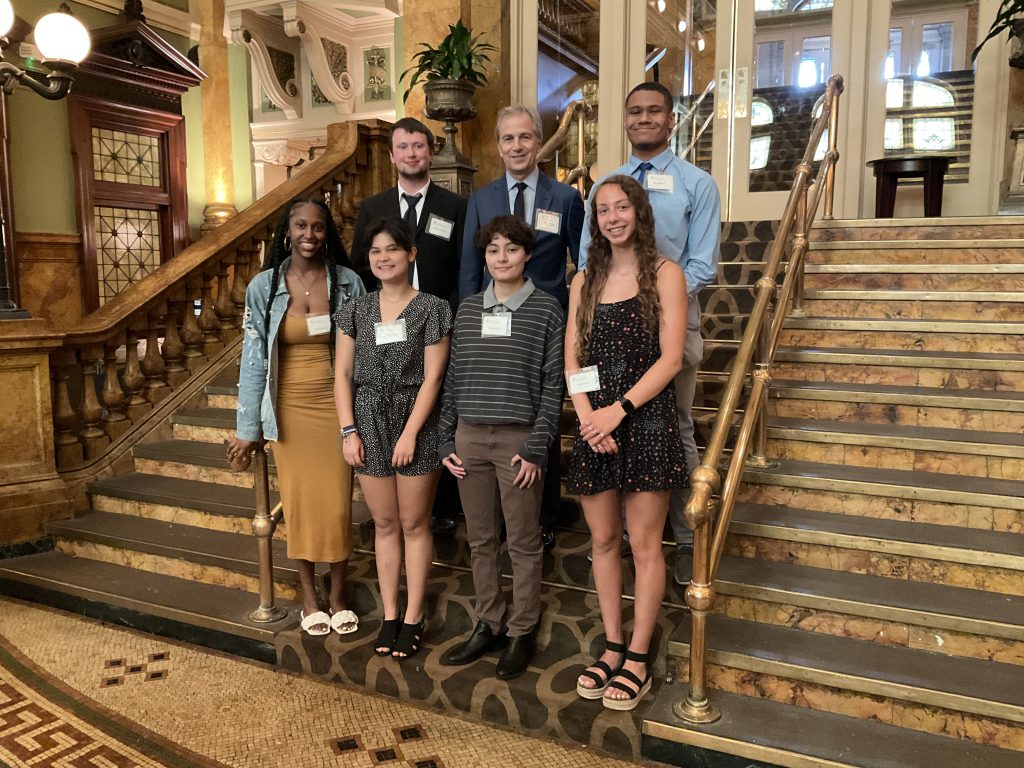
David Brashear, chairman of our Landmarks Scholarship Committee paused with scholarship and honorable mention winners at a reception held in the Grand Concourse restaurant. From top left: Maclaen Johnson, David Brashear (standing center), Clark McCord. From bottom left: Desirae Nance, Madeline Douglas, Negein Immen, Mia Schubert
David Brashear, chairman of our organization’s Landmarks Scholarship Committee presented winners of three scholarships and 11 honorable mention award recipients at a reception held at the Grand Concourse restaurant in Station Square on June 27.
The financial award for our scholarship is $6000 paid directly to the recipient’s account at the college or university of their choice. The scholarship winners include:
- Maclaen Johnson, is a graduate of Bishop Canevin High School and a Junior Councilperson of Carnegie Borough. He will study History and Political Science at the University of Notre Dame.
- Clark McCord, a graduate of Central Catholic High School, will pursue Civil Engineering and Architectural Studies at the University of Pittsburgh.
- Luke Smarra, is a graduate of Montour High School and will study Economics and Art History at Tulane University.
Eleven students received $250 as a one-time honorable mention award, which will also be paid directly to their accounts at their college or university of choice. Honorable mention recipients include:
- Madeline Douglas a graduate of Woodland Hills High School will study biomedical engineering at Columbia University.
- Negein Immen a graduate of Pine Richland High School will study Civil Engineering at Penn State University.
- Desirae Nance, a graduate of Sewickley Academy will study Chemical Engineering at Hampton University.
- Mia Schubert, a graduate of Shaler Area High School, will stud Biology and Business at Juniata College.
- Aubree Arelt, a graduate of Serra Catholic High School, will study Economics at West Virginia University.
- Christian Cropper, a graduate of Eden Christian Academy, will study business at Hope College.
- Christian Duckworth, a graduate of North Allegheny Senior High School, will study Architecture at Rensselaer Polytechnic Institute.
- Madison Martin, a graduate of Sewickley Academy, will study Psychology at New York University.
- Elizabeth Neel, a graduate of Pittsburgh CAPA will study Early Education at Temple University
- Hailey Shevitz, a graduate of Pittsburgh Allderdice will study International Relations at the University of Wisconsin-Madison.
- Melaina Thompson, a graduate of Pittsburgh CAPA will study Art at Cornell University.
Since 1999, our organization’s Scholarship Committee has awarded 85 scholarships, payable over four years, and 51 honorable mentions, a one-time gift. In doing so, we have connected with 136 high-achieving, community-minded young people who care deeply about the Pittsburgh region and recognize the value of historic preservation.
This program is funded by the Brashear Family Fund, Scholarship Committee members, and the Landmarks Scholarship Fund, including donations to the 2008 and 2014 Scholarship Celebrations. We thank each donor for supporting this program that helps young people achieve their educational goals and stay connected to the Pittsburgh region through our organization.
-
Three Winners and Eleven Honorable Mention to Receive Landmarks Scholarship
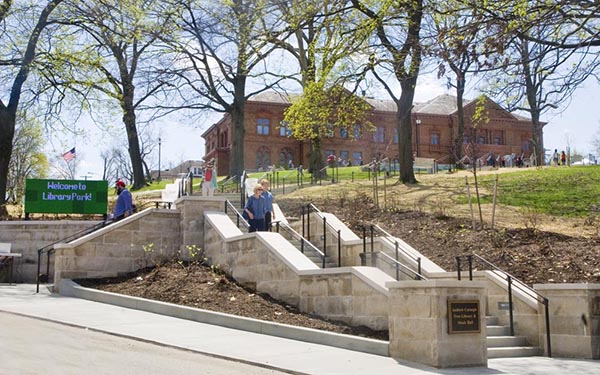
Maclaen Johnson, one of the 2022 Landmarks Scholarship winners, wrote about the Andrew Carnegie Free Library & Music Hall in Carnegie, PA. By sixth grade, he was volunteering at the library. He wrote: “I developed self-confidence and enriched my knowledge of history inside the storied structure.” The Carnegie Carnegie, as the building is now called, recently dedicated a beautifully landscaped Library Park.
“It’s a remarkable achievement,” said PHLF Trustee David Brashear. “Since 1999, PHLF has awarded 85 scholarships and 51 honorable mentions to high school graduates from Allegheny County who care deeply about the Pittsburgh region and are pursuing an undergraduate degree at a college or university of their choice.”
Mr. Brashear’s family initiated the Landmarks Scholarship Program in 1999 through a Donor-Advised Fund at PHLF. Foundations, businesses, and many PHLF members have generously contributed since then. The scholarship award of $6,000 is payable over four years to the recipient’s college/university to help pay tuition and book expenses; the honorable mention award is a one-time gift of $250, payable to the recipient’s college/university.
The following people were awarded scholarships at the May 16 Committee meeting:
- Maclaen Johnson (Bishop Canevin High School/University of Notre Dame);
- Clark McCord (Central Catholic High School/University of Pittsburgh)
- Luke Smarra (Montour High School/Tulane University).
The following were awarded honorable mentions:
- Aubree Arelt (Serra Catholic High School/West Virginia University);
- Christian Cropper (Eden Christian Academy/Hope College);
- Madeline Douglas (Woodland Hills High School/Columbia University);
- Christian Duckworth (North Allegheny Senior High School/Rensselaer Polytechnic Institute);
- Negein Immen (Pine Richland High School/Penn State University);
- Madison Martin (Sewickley Academy/New York University);
- Desirae Nance (Sewickley Academy/Florida Agricultural and Mechanical University);
- Elizabeth Neel (Pittsburgh CAPA/Temple University);
- Mia Schubert (Shaler Area High School/Juniata College);
- Hailey Shevitz (Pittsburgh Allderdice/University of Wisconsin-Madison); and
- Melaina Thompson (Pittsburgh CAPA/Cornell University).
The recipients will be recognized during a reception in June at the Grand Concourse restaurant in Station Square.
The Scholarship Program has helped introduce young people to the work and mission of PHLF and has created a network of support and a sense of family among the recipients. Two former scholarship recipients are now trustees of PHLF––Todd Wilson and Kezia Ellison––and many others contribute their time and expertise as members.
Applicants are asked to write about a place in Allegheny County that is meaningful to them. The essays this year were outstanding and insightful. Featured places included the Allegheny Observatory, Andrew Carnegie Free Library & Music Hall, Benedum Center for the Performing Arts, Cathedral of Learning, Carnegie Museum of National History & Art, First English Evangelical Lutheran Church, Fort Pitt Museum, Freedom Corner, Frick Park, Fulton Log House, Hartwood Acres, Homestead Grays Bridge, Sarah Heinz House, Kennywood Park, Sue Murray Swimming Pool, North Park, South Park, Washington’s Landing, and White Oak Park.
PHLF welcomes contributions in support of the Landmarks Scholarship Program which will be celebrating its 25th anniversary in 2023.
Please click here to contribute; be sure to designate your gift to “Scholarship.”
Thank you!

